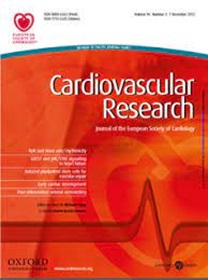Phenotypic spectrum of cardiac conduction disturbance and cardiomyopathy linked to titin canonical splice-site variants.
IF 13.3
1区 医学
Q1 CARDIAC & CARDIOVASCULAR SYSTEMS
引用次数: 0
Abstract
AIMS Truncating variations in the titin gene (TTNtv) are the most common genetic cause of dilated cardiomyopathy (DCM) and have been implicated in various arrhythmic and heart failure phenotypes. Nonetheless, predicting the pathogenicity of a distinct subtype of TTNtv, canonical splice-site variations (TTNcsv), remains challenging. Furthermore, the precise transcriptional and phenotypic consequences associated with TTNcsv remain unclear. We evaluated the transcriptional profiles of TTN in vitro, focusing on TTNcsv found in patients with cardiac dysfunction, and compared them with their phenotypic manifestations. METHODS AND RESULTS Genome-wide linkage analysis, whole-exome sequencing and whole-genome sequencing were performed on a five-generation family with cardiac conduction disturbance (CCD). In addition, whole-genome sequencing was performed on 402 Japanese biobank patients with cardiomyopathy or unidentified cardiac dysfunction. Transcriptional profiles of TTNcsv were evaluated by RNA-Seq of induced pluripotent stem cell-derived cardiomyocytes and endomyocardial biopsy specimens, and by minigene assays. A rare segregating TTNcsv (c.49049-2A>C) was identified in the five-generation family with CCD. RNA-Seq and minigene assays revealed complex aberrant TTN splicing transcripts: predominant non-truncating transcripts caused by an 18-bp in-frame deletion (83-90%) and minor truncating transcripts (10-17%). Two additional TTNcsv were identified in biobank participants by whole-genome sequencing. A minigene assay of TTNcsv c.67348+1G>A, identified in a CCD patient with mild cardiac dysfunction, revealed predominant non-truncating transcripts (95%), caused by retention of a 90-bp in-frame intron, along with 5% truncating TTN transcripts, caused by a 50-bp frameshift deletion, mirroring the TTNcsv observed in the familial CCD. In contrast, the DCM-associated TTNcsv c.67637-2A>G generated 87% truncating TTN transcripts, attributed to frameshift intron retention and cryptic splicing. CONCLUSIONS The clinical data from this family suggest a close association between TTNcsv and CCD, which may involve an increase in non-truncating transcripts. Further studies are required to determine their precise relationship and the underlying mechanisms.与titin典型剪接位点变异相关的心脏传导障碍和心肌病的表型谱。
titin基因(TTNtv)的突变是扩张型心肌病(DCM)最常见的遗传原因,并与各种心律失常和心力衰竭表型有关。尽管如此,预测TTNtv的一个不同亚型,典型剪接位点变异(TTNcsv)的致病性仍然具有挑战性。此外,与TTNcsv相关的确切转录和表型后果仍不清楚。我们在体外评估了TTN的转录谱,重点关注心功能障碍患者中发现的TTNcsv,并将其与表型表现进行了比较。方法与结果对一个心脏传导障碍(CCD)五代家族进行全基因组连锁分析、全外显子组测序和全基因组测序。此外,对402例日本生物银行心肌病或不明心功能障碍患者进行了全基因组测序。TTNcsv的转录谱通过诱导多能干细胞来源的心肌细胞和心内膜活检标本的RNA-Seq和minigene检测进行评估。在患有CCD的五代家族中发现了一种罕见的分离性TTNcsv (C .49049- 2a >C)。RNA-Seq和minigene分析揭示了复杂的异常TTN剪接转录本:主要由18 bp帧内缺失(83-90%)和次要截断转录本(10-17%)引起的非截断转录本。通过全基因组测序在生物库参与者中鉴定了另外两个TTNcsv。在一名患有轻度心功能障碍的CCD患者中鉴定出TTNcsv c.67348+1G>A的小基因分析显示,主要的非截断转录本(95%)是由90 bp的帧内内含子保留引起的,同时还有5%的截断TTN转录本是由50 bp的移码缺失引起的,这与家族性CCD中观察到的TTNcsv相似。相比之下,dcm相关的TTNcsv c.67637-2A>G产生了87%的截断TTN转录本,这归因于移码内含子保留和隐式剪接。结论来自该家族的临床数据表明TTNcsv与CCD之间存在密切关联,这可能涉及非截断转录本的增加。需要进一步的研究来确定它们的确切关系和潜在机制。
本文章由计算机程序翻译,如有差异,请以英文原文为准。
求助全文
约1分钟内获得全文
求助全文
来源期刊

Cardiovascular Research
医学-心血管系统
CiteScore
21.50
自引率
3.70%
发文量
547
审稿时长
1 months
期刊介绍:
Cardiovascular Research
Journal Overview:
International journal of the European Society of Cardiology
Focuses on basic and translational research in cardiology and cardiovascular biology
Aims to enhance insight into cardiovascular disease mechanisms and innovation prospects
Submission Criteria:
Welcomes papers covering molecular, sub-cellular, cellular, organ, and organism levels
Accepts clinical proof-of-concept and translational studies
Manuscripts expected to provide significant contribution to cardiovascular biology and diseases
 求助内容:
求助内容: 应助结果提醒方式:
应助结果提醒方式:


